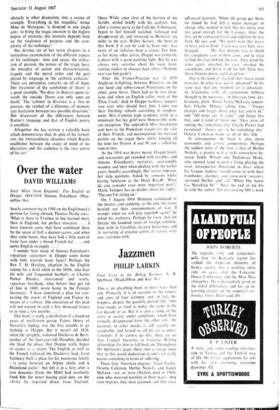Racine's art
MARTIN TURNELL
Racine or The Triumph of Relevance Odette de Mourgues (cur,: hard cover, 30s; paper- back, 12s 6d) With the exception of Moliere, the classic French dramatists have always been a difficulty for Anglo-Saxon audiences because their work is so unlike our native wares. The French themselves are not without responsibility in the matter. Until comparatively recently, there was little good criticism of Racine even in France and the repertoires of the French national theatres are pitifully narrow compared with the treatment in England of Shakespeare or the contemporary Elizabethans. Corneille re- mains a stumbling-block hardly helped by the production of Le Cid as 'black comedy' at this year's World Theatre.
In the case af Racine, Lytton Strachey's essays achieved a partial breakthrough, but there are still difficulties. Mme de Mourgues tells us that she has 'met a number of intelli- gent people who admitted with great honesty that Racine left them unmoved, although they possessed in theory very sound and very pre- cise notions on the perfection of his tragedies.'
For this reason a book on Racine in English by a French critic deserves a warm welcome. As a lecturer at Cambridge and the author of a thesis on English and French poetry in the sixteenth and seventeenth centuries, Mme de Mourgues is well qualified to deal with the difficulties. She keeps two facts firmly in front of us. A tragedy by Racine is a living entity which offers an immensely powerful experi- ence. We can only participate in it to the full provided we understand that he was a seventeenth century dramatist who must be appreciated as such. Mme de Mourgues makes no concessions to contemporary theories which are designed to reduce or gloss over the differences between Racine's age and our own. His characters are not brought down to the level of ordinary human beings: the spectator is brought up to the level of those human beings who are exceptional. 'The triumph of relevancy' lies partly in the way in which Racine turned conventions, which were an
obstacle to other dramatists, into a source of strength. 'Everything in his tragedies,' writes Mme de Mourgues, 'is directed to one single aim: to bring the tragic emotion to the highest degree of intensity; this intensity depends both on the singleness of purpose and the com- plexity of the technique.'
She devotes six of her seven chapters to a meticulous examination of the different aspects of his technique: time and space, the stylisa- tion of passion, the nature of the tragic hero, the interplay of action and characterisation, tragedy and the moral order and the part played by language in 'the aesthetic catharsis.' There are perceptive remarks on all of them. Her treatment of the symbolism of 'doors' is a goad example. `No door in Bajazet opens to- wards the outside. Doors can only open on death.' The 'cabinet' in Berenice is a 'lieu de passage, the symbol of a dilemma, of momen- tary hesitation between two possible directions.' Her discussion of the differences between Racine's language and that of English poetry is excellent.
Altogether she has written a valuable book which demonstrates that, in spite of his formal- ism, the 'extraordinary closeness which Racine establishes between the states of mind of his characters and the audience is the very centre of his art.'































 Previous page
Previous page